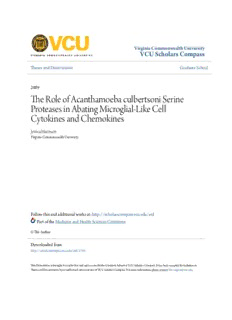
The Role of Acanthamoeba culbertsoni Serine Proteases in Abating Microglial-Like Cell Cytokines ... PDF
Preview The Role of Acanthamoeba culbertsoni Serine Proteases in Abating Microglial-Like Cell Cytokines ...
VViirrggiinniiaa CCoommmmoonnwweeaalltthh UUnniivveerrssiittyy VVCCUU SScchhoollaarrss CCoommppaassss Theses and Dissertations Graduate School 2009 TThhee RRoollee ooff AAccaanntthhaammooeebbaa ccuullbbeerrttssoonnii SSeerriinnee PPrrootteeaasseess iinn AAbbaattiinngg MMiiccrroogglliiaall--LLiikkee CCeellll CCyyttookkiinneess aanndd CChheemmookkiinneess Jenica Harrison Virginia Commonwealth University Follow this and additional works at: https://scholarscompass.vcu.edu/etd Part of the Medicine and Health Sciences Commons © The Author DDoowwnnllooaaddeedd ffrroomm https://scholarscompass.vcu.edu/etd/1764 This Dissertation is brought to you for free and open access by the Graduate School at VCU Scholars Compass. It has been accepted for inclusion in Theses and Dissertations by an authorized administrator of VCU Scholars Compass. For more information, please contact [email protected]. © Jenica Ledah Harrison 2009 All Rights Reserved THE ROLE OF ACANTHAMOEBA CULBERTSONI SERINE PROTEASES IN ABATING MICROGLIAL-LIKE CELL CYTOKINES AND CHEMOKINES A dissertation submitted in partial fulfillment of the requirements for the degree of Doctor of Philosophy at Virginia Commonwealth University. by JENICA LEDAH HARRISON B.S., Western Carolina University, 2000 Director: GUY A. CABRAL, PHD PROFESSOR, DEPARTMENT OF MICROBIOLOGY AND IMMUNOLOGY Virginia Commonwealth University Richmond, Virginia April, 2009 ii Acknowledgements I would like to thank the following individuals for their support during my graduate career. Without your help I would not have been able to complete this program. A special thanks to my Lord and Savior Jesus Christ who has walked with me every step of my journey. I am grateful to my advisor, Dr. Guy A. Cabral for allowing me to pursue my research in his laboratory. Over the years, he has taught me the importance of “allowing the data to speak” to the direction of the research. Most importantly, he has also taught me how to be an upstanding research scientist. I would also like to thank Dr. Francine Marciano-Cabral for all of her guidance and assistance with my research project. I would like to thank my other graduate committee members; Dr. Kathleen McCoy, Dr. Michael McVoy, and Dr. Sandra Welch for their advice and interest in my research. I would also like to thank Dr. Joy Ware and Dr. Dan Huang for teaching me the two-dimensional (iso-dalt) gel electrophoresis technique. I am thankful to the National Institutes of Health for their financial support while pursuing my graduate degree. I would also like to thank Daniel Southern and Dr. Christine Stevens of the Clinical Laboratory Sciences Program at Western Carolina University for introducing me to clinical Microbiology and Immunology and encouraging my interest in research. While pursuing this graduate degree I have had the honor of working with several people in the Cabral and Marciano-Cabral laboratories that I would like to thank: Dr. iii Tammy Ferguson, Dr. Angela Fritzinger, Dr. Andrea Staab, Dr. Rebecca MacLean, Dr. Erinn Raborn, Dr. Gabriela de Almeida Ferreira, Dr. Bruno da Rocha Azevedo, Dr. Daniel Fraga, Dr. LaToya Griffin-Thomas, Christina Hartman, Melissa Jamerson, Alex Mensah, and Olga Tavares-Sanchez. Last, but definitely not least, I could like to thank my family; my mother Jeanette Harrison, my father Jerry Harrison (deceased), my grandmother Viola M. Harrison (deceased), Joyce Jefferson, Jasmin Bhalodia, Ronald Saunders, William Day, and Deborah Day. Thanks for your prayers, advice, guidance, and love. You all have been an integral part of my life and for that I am forever grateful. iv Table of Contents Page Acknowledgements ............................................................................................................. ii List of Tables ..................................................................................................................... vi List of Figures .................................................................................................................. vii Abstract ...............................................................................................................................x Introduction..........................................................................................................................1 Materials and Methods .......................................................................................................17 Reagents ......................................................................................................17 Amoebae ......................................................................................................17 Microglia .....................................................................................................18 Conditioned Medium ...................................................................................18 Two-Dimensional (Iso-Dalt) Gel Electrophoresis (2D-PAGE) ..................20 Gel Zymography ..........................................................................................21 Light Microscopy ........................................................................................22 Multiprobe Ribonuclease Protection Assay (RPA) .....................................22 Cytokine/Chemokine Protein Microarray ...................................................23 Enzyme-Linked Immunosorbent Assay (ELISA) .......................................24 Data Analysis ..............................................................................................25 Results...............................................................................................................................26 v Discussion…………………………………………………………………....................57 Literature Cited……………………………………………………………....................69 vi List of Tables Page Table 1: Genotypes of Acanthamoeba Associated with Disease in Humans...................4 vii List of Figures Page Figure 1: Life Cycle Forms of Acanthamoeba ....................................................................2 Figure 2: Characteristic Granuloma Associated with Granulomatous Amoebic Encephalitis (GAE) ..............................................................................................8 Figure 3: Visualization of Complete Neurobasal™-A Medium Proteins ..........................27 Figure 4: Visualization of A. culbertsoni-Conditioned Medium Proteins .........................28 Figure 5: A Comparison of the Effect of Propagation Medium on A. culbertsoni Protease Activity ................................................................................................30 Figure 6: Titration of Protease Activity in 109 A. culbertsoni-Conditioned Medium ........31 Figure 7: Acanthamoeba culbertsoni Secrete Proteases that Are Inhibited by the Serine Protease Inhibitor Phenylmethylsulphonylfluoride (PMSF) ...................33 Figure 8: Acanthamoeba culbertsoni Secrete Proteases that Are Not Inhibited by the Cysteine Protease Inhibitor trans-Epoxysuccinyl-L-leucylamido (4-guanidino)butane (E-64) ................................................................................34 Figure 9: A Comparison of the Proteolytic Activity in Three Different Types of A. culbertsoni-Conditioned Media .................................................................35 Figure 10: Acanthamoeba culbertsoni-Conditioned Medium Proteolytic Activity Increases in a Time-Related Manner and Is Augmented During Co-Culture With BV-2 Cells ...............................................................................................37 viii Figure 11: Acanthamoeba culbertsoni Induces Chemokine mRNA Expression by BV-2 Cells ........................................................................................................38 Figure 12: Cytokine and Chemokine Protein Expression by BV-2 Cells following 9 h Co-culture with A. culbertsoni. ...................................................................40 Figure 13: Cytokine and Chemokine Protein Expression by BV-2 Cells following 24 h Co-culture with A. culbertsoni ..................................................................41 Figure 14: Light Microscopy Images of BV-2 cells, A. culbertsoni, and BV-2 cells Plus A. culbertsoni Co-cultures ........................................................................43 Figure 15: Conditioned Medium from A. culbertsoni Degrades Constitutively Expressed Cytokines and Chemokines Elicited by BV-2 Cells........................45 Figure 16: Effect of 109 A. culbertsoni-Conditioned Medium (ACM-HI) on BV-2 Cell Morphology ...............................................................................................47 Figure 17: Conditioned Medium from A. culbertsoni Degrades Cytokines and Chemokines Elicited from Lipopolysaccharide (LPS) Stimulated BV-2 Cells ..................................................................................................................48 Figure 18: Acanthamoeba culbertsoni Proteases Degrade A. culbertsoni Induced Microglial Chemokines from BV-2 cells ..........................................................50 Figure 19: Acanthamoeba culbertsoni Protease Activity Persists in Co-culture Supernatants Following Incubation for 72 h .....................................................52 Figure 20: Acanthamoeba culbertsoni Serine Proteases Degrade TNF-α .........................53 Figure 21: Acanthamoeba culbertsoni Serine Proteases Degrade MIP-1α ........................54
Description: